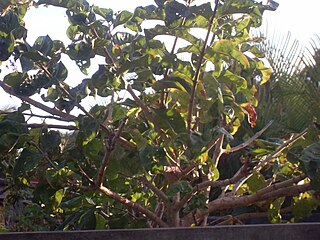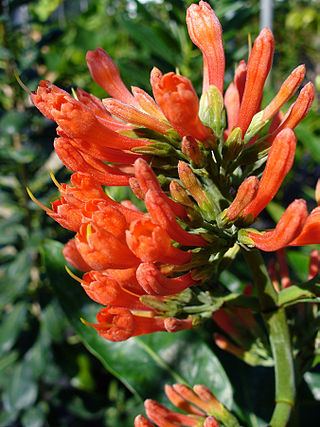
The Rubiaceae are a family of flowering plants, commonly known as the coffee, madder, or bedstraw family. It consists of terrestrial trees, shrubs, lianas, or herbs that are recognizable by simple, opposite leaves with interpetiolar stipules and sympetalous actinomorphic flowers. The family contains about 13,500 species in about 620 genera, which makes it the fourth-largest angiosperm family. Rubiaceae has a cosmopolitan distribution; however, the largest species diversity is concentrated in the tropics and subtropics. Economically important genera include Coffea, the source of coffee, Cinchona, the source of the antimalarial alkaloid quinine, ornamental cultivars, and historically some dye plants.
Thecacoris is a genus of flowering plant belonging to the family Phyllanthaceae first described as a genus in 1821. It is native to tropical Africa and Madagascar. It is dioecious, with male and female flowers on separate plants, although it may rarely be monoecious.

Bertiera is a genus of flowering plants in the family Rubiaceae. It comprises 57 species with most known from tropical Africa, five known from various Indian Ocean islands and five found in the tropics of the Americas.
Carphalea is a genus of flowering plants in the family Rubiaceae. It is endemic to Madagascar.

Rothmannia is a genus of flowering plants in the family Rubiaceae. It was described in 1776 and is named for Göran Rothman (1739–1778) by Thunberg – both were pupils of Linnaeus.
Rytigynia is a genus of flowering plants in the family Rubiaceae. It is found in tropical and southern Africa. The genera Rytigynia and Fadogia form a strongly supported clade but neither of these genera is monophyletic.

Burchellia is a monotypic genus of flowering plants in the family Rubiaceae. The genus contains only one species, viz. Burchellia bubalina, which is endemic to southern Africa: the Cape Provinces, KwaZulu-Natal and the Northern Provinces in South Africa, and Eswatini. It is commonly known as wild pomegranate (English) or wildegranaat (Afrikaans).

Breonia is a genus of flowering plants in the family Rubiaceae. It is endemic to Madagascar. Most species are trees, rarely shrubs.

Vanguerieae is a tribe of flowering plants in the family Rubiaceae and contains about 655 species in 30 genera. It is one of the most species-rich groups within the family and it is distributed across the Paleotropics.

Vangueria madagascariensis, commonly known by the names Spanish-tamarind, tamarind-of-the-Indies, or voa vanga, is a species of flowering plant in the family Rubiaceae native to the African continent having edible fruit. It is the type species of the genus Vangueria and was described in 1791 by Johann Friedrich Gmelin.
Globulostylis is a genus of flowering plants in the family Rubiaceae. It comprises 8 species growing in Central Africa.
Bremeria is a genus of flowering plants in the family Rubiaceae. It was described in 2005 to accommodate all the Indian Ocean species formerly placed in Mussaenda, except the widespread Mussaenda arcuata. The genus is indigenous to Madagascar, Mauritius and Réunion, and is found in humid to subhumid evergreen forests.
Coptosperma is a genus of flowering plants in the family Rubiaceae. It contains 19 species native to Africa, the Arabian Peninsula, and various islands of the Indian Ocean.

Alberteae is a tribe of flowering plants in the family Rubiaceae and contains about 18 species in 3 genera. Its representatives are found in tropical and southern Africa and in Madagascar.
Petchia madagascariensis is a plant in the family Apocynaceae.
Chapelieria is a monotypic genus of flowering plants in the family Rubiaceae. The genus contains only one species, viz. Chapelieria madagascariensis, which is endemic to Madagascar.
Phylohydrax is a genus of plants in the family Rubiaceae. Its species are native to Madagascar, Tanzania and South Africa.

Octotropideae is a tribe of flowering plants in the family Rubiaceae and contains about 103 species in 18 genera. Its representatives are found in the paleotropics. The genera previously placed in the tribe Hypobathreae are now placed in Octotropideae.
Flagenium is a genus of flowering plants in the family Rubiaceae. The genus is endemic to Madagascar.
Herbert Fuller Wernham was a British botanist, who from 1909 to 1929 worked at the British Museum, as an assistant in the botany department. From 1911 to 1921 he published extensively on tropical plants and many genera, retiring in 1921 due to ill health (alcoholism).








